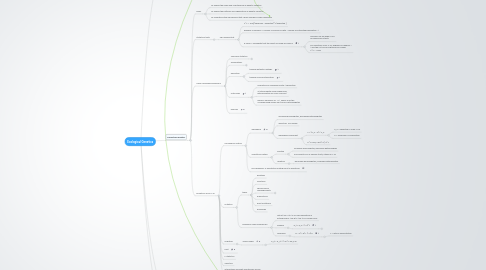
1. What is Ecological Genetics?
1.1. Genetics of ecologically important traits
1.1.1. survival
1.1.2. reproduction
1.1.2.1. mating success
1.1.2.2. offspring
1.2. Study of the process of phenotypic evolution occurring in present day populations
1.2.1. Darwin's explanatory model of natural selection (Mayr)
1.2.1.1. Observation 1:
1.2.1.1.1. Every population has such high fertility that its size would increase exponentially if not constrained.
1.2.1.2. Observation 2:
1.2.1.2.1. The size of populations, except for temporary annual fluctuations, remains stable over time
1.2.1.3. Observation 3:
1.2.1.3.1. The resources available to every species are limited
1.2.1.4. Inference 1:
1.2.1.4.1. There is intense competition (struggle for existence) among members of a species
1.2.1.5. Observation 4:
1.2.1.5.1. No two individuals of a population are exactly the same
1.2.1.6. Inference 2:
1.2.1.6.1. Individuals of a population differ from each other in the probability of survival (i.e., natural selection)
1.2.1.7. Observation 5:
1.2.1.7.1. Many of the differences among individuals of a population are, at least in part, heritable
1.2.1.8. Inference 3:
1.2.1.8.1. Natural selection, continued over many generations, results in evolution
1.2.2. Mechanisms of evolution
1.2.2.1. Mutation
1.2.2.2. Drift
1.2.2.3. Gene flow
1.2.2.4. Selection
2. Population genetics
2.1. Goals
2.1.1. To explain the origin and maintenance of genetic variation
2.1.2. To explain the patterns and organization of genetic variation
2.1.3. To understand the mechanisms that cause changes in allele frequency
2.2. Statistical tests
2.2.1. Chi-squared test
2.2.1.1. X^2 = Sum[(observed - expected)^2 /expected ]
2.2.1.2. degrees of freedom = number of classes of data - number of estimated parameters - 1
2.2.1.3. p-value = probability that the result occurred by chance
2.2.1.3.1. Typically use an alpha of 0.5 for significance tests
2.2.1.3.2. For deviations from H-W, degrees of freedom = 1 and the cut-off for significance is when X^2>~=3.84
2.3. Hardy-Weinberg equilibrium
2.3.1. Summary statistics
2.3.1.1. p + q = 1
2.3.1.1.1. p = (2n_AA + n_Aa) / 2n
2.3.1.1.2. q = (2n_aa + n_Aa_Aa) / 2
2.3.1.1.3. (p + q)^2 = p^2 + 2pq + q^2 = 1
2.3.1.2. P + H + Q = 1
2.3.1.2.1. P = p^2
2.3.1.2.2. Q = q^2
2.3.1.2.3. H = 2pq
2.3.1.2.4. p = P + H/2
2.3.1.2.5. q= Q + H/2
2.3.2. Assumptions
2.3.2.1. diploid, sexual, discrete generations
2.3.2.2. allele frequencies are the same in both sexes
2.3.2.3. Mendelian segregation
2.3.2.4. random mating
2.3.2.5. no mutation
2.3.2.6. no migration
2.3.2.7. no drift (implies very large populations)
2.3.2.8. no selection
2.3.3. Derivation
2.3.3.1. through potential matings
2.3.3.2. through cross multiplication
2.3.4. Outcomes
2.3.4.1. Populations in equilibrium after 1 generation
2.3.4.2. At intermediate allele frequencies, heterozygotes are more common
2.3.4.3. Below a frequency of ~0.1, nearly all of the corresponding alleles are found in heterozygotes
2.3.5. exercise
2.4. Deviations from H-W
2.4.1. Nonrandom mating
2.4.1.1. Inbreeding
2.4.1.1.1. increases homozygotes, decreases heterozygotes
2.4.1.1.2. affects all loci equally
2.4.1.1.3. inbreeding coefficient
2.4.1.2. Assortitive Mating
2.4.1.2.1. positive
2.4.1.2.2. negative
2.4.1.3. Do inbreeding or assortative mating result in evolution?
2.4.2. Mutation
2.4.2.1. types
2.4.2.1.1. deletions
2.4.2.1.2. insertions
2.4.2.1.3. chromosomal rearrangements
2.4.2.1.4. duplications
2.4.2.1.5. point mutations
2.4.2.1.6. polyploidy
2.4.2.2. changes in allele frequencies
2.4.2.2.1. rate at 10e-4 to 10 e-6 per generation in mitochondria...10e-8 to 10e-10 in nuclear DNA
2.4.2.2.2. forward
2.4.2.2.3. reversible
2.4.3. Migration
2.4.3.1. island model
2.4.3.1.1. p_i,t = p_i,t-1 (1-m) + bar_p m
2.4.4. Drift
2.4.5. F-statistics
2.4.6. Selection
2.4.7. Interactions amongst evolutionary forces
